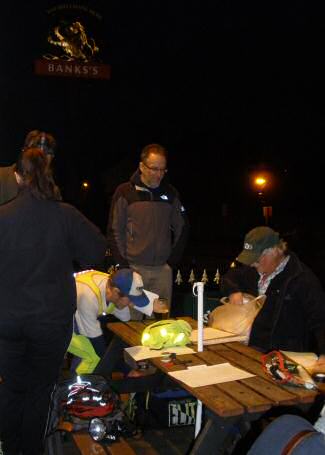

We now have a decent programme, but we do need a new coordinator...
Each event has a choice of 3 courses -
Short approx. 4 km, Medium approx 6km, Long approx 8km. A headlamp / torch is highly advisable,
but it need not be a full-power terrain night-O one. You should also wear a light / reflective top
to help ensure you are seen.
Whistles are now also required.
2014 - 2015 Programme
Final League table after all 5 events
| Date | Venue | Organiser | Details | Results | |
|---|---|---|---|---|---|
| 1 | Thu 13 Nov | Walmley | Bob Scott | Results | |
| 2 | Thu 11 Dec | Handsworth Wood and Hamstead | Andy White | Results | |
| 3 | Wed 28 Jan | Sutton Coldfield | Dave Ellis | Results | |
| 4 | Thu 05 Feb | King George V Fields, Worcester | John Leeson | Event postponed | |
| 5 | Thu 19 Feb | West Bromwich town centre | Andy White | Results v2 issued 23 Feb | |
| 6 | Thu 19 Mar | Spennells, Kidderminster | Russ Fauset | Results
Adrian Bailey's Medium Course route trace |
This website contains mapping data licensed from Ordnance Survey with the permission of the Controller of Her Majesty's Stationery Office. © Crown Copyright. All rights reserved. Licence number PU43423U.
Please note that information, views, statements and images forming part of this site are subject to the site disclaimer.
The normal time for starts is 6:30 to 7:30pm, in order to avoid the worst of the rush hour traffic. Earlier starts will be available at some events and may possibly be negotiated by individuals at others.
Short (around 4km), Medium (around 6km) and Long (around 9km) courses are available. Trophies are awarded for overall winners on each course at the end of the season.
Events use urban streets and paths, with the occasional stretch of open space or canal towpath. A headlight or torch is often useful, particularly for the longer courses, but it doesn't need to be particularly powerful - enough to see your footing and read the map.
Participants are responsible for their own safety and take part at their own risk. Courses may cross main roads and some reflective clothing is advisable.
2013-2014 page
2013/2014 season league table
2012-2013 page
2012/2013 season league table
2011-2012 page
2011/2012 season league table
2010-2011 page
2010/2011 season league table
2009-2010 page
2009/2010 season league table
2008-2009 page
2008/2009 season league table
2007-2008 page
2007/2008 season league table
2006-2007 page
2006/2007 season league table
2005-2006 page
2005/2006 season league table
2004/2005 season league table
2003/2004 season league table
 Russ Fauset in charge at the 2010 Droitwich event centre.
Russ Fauset in charge at the 2010 Droitwich event centre.



